What you need to know about wild rice (and an easy pilaf to get you started)
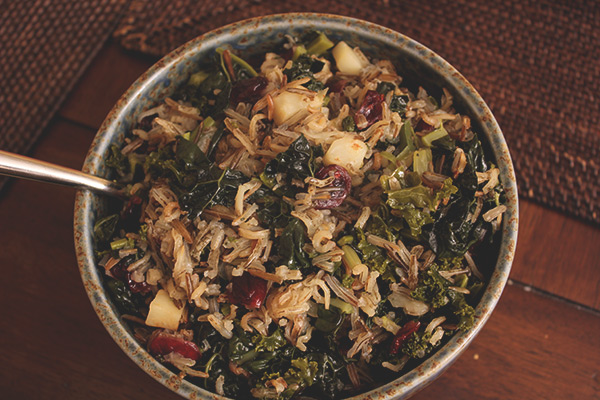
I’ve been feeling a little remiss in my duties as a Minnesotan lately, considering how little I’ve talked about wild rice over the years I’ve had this site. We don’t eat it as often as we should, and that’s probably where the guilt actually lies, but I’m determined to remedy the situation and so here I am.
I know I’ve mentioned wild rice here and again, but let’s back up and get a good handle on the whole business. Wild rice (which is not actually a rice, but we’ll get to that) looks like very long long-grain rice covered by a thin brownish-blackish skin. When properly cooked, that skin breaks open and most of the grains begin to curl in on themselves, which many recipes refer to as “blossoming.” The grains still have their bran intact, which gives it a toothsome, chewy texture similar to brown rice and other whole grains. It has a toasty, nutty, earthy flavor, and can often smell and taste slightly like black tea. The flavor and texture it adds over other rices and grains is worth the extra effort required in cooking it, and it’s interesting to add to soups, breads, salads, and other dishes in a way that other grains seem to act more as mere filler or heft.
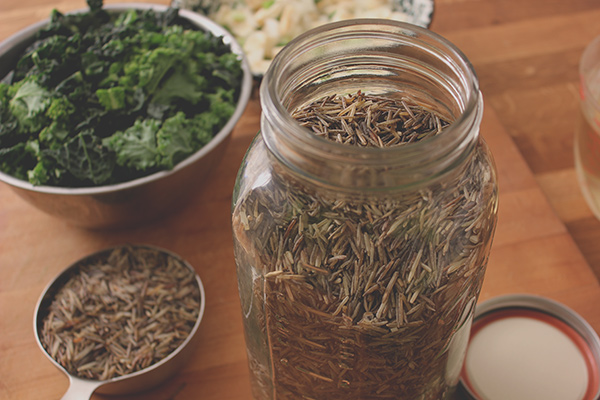
That said, I’m from Minnesota. I get it. I’ve eaten wild rice my whole life, and in a million different ways. I’ve always known the difference between real wild rice and the other stuff, just like someone from the Northwest knows about wild salmon and someone from New Mexico knows about real green chile. Wild rice isn’t nearly as pervasive of a thing as those other two, so don’t feel bad if you have no idea where I’m going with this – just know that there’s a difference.
So let’s start at the beginning: wild rice isn’t a rice at all. It’s a long-grain marsh grass native to the northern Great Lakes areas, and it’s been harvested by Native American communities for hundreds of years. It grows in the shallow waters of lakes, tidal rivers, and bays, and is incredibly labor intensive to harvest and process for consumption, since in its natural form it’s covered by a hard, inedible husk. After harvesting, the grains are left to sit in moist piles so they can continue to mature, then the rice is toasted over a fire to dry it, add flavor, and make the husk brittle enough that it can be more easily removed. This process, along with how difficult it is to cultivate and grow in controlled environments, is why wild rice tends to be fairly rare and pricey (especially for the good, wild, hand-harvested stuff). These days, the vast majority of the wild rice sold in the United States is cultivated in controlled fields similar to rice paddies, and most is grown in California instead of its native Midwestern environments.
So here’s where I get all Minnesotan on you. Cultivated paddy wild rice is certainly still delicious and worth buying if you like wild rice, but if you can get your hands on the truly wild, hand-cultivated, fire-parched stuff, that’s really where it’s at. Real, hand-harvested wild rice is a tough business, especially once industrial operations in California began taking over the market, but you know that if you’re buying the real stuff that you’re supporting small, community-based operations. (And that you’re about to eat something truly special and delicious.) My grandmother and I buy and share large bags of it from Scenic Waters, who sells at the Minneapolis Farmers’ Market and will ship, but if you’re not able to do that or purchase direct from another harvester, you can know what you’re getting by reading labels. Anything from California is artificially cultivated, and if it’s from Minnesota, it must say that “paddy” or “cultivated” on the label if it’s not truly wild. (I also just did a quick google of “Minnesota wild rice buy online,” and a number of great options came up.)
So let’s get to the cooking part. Whether you have cultivated or wild wild rice, you have a number of options for cooking. The most basic way to cook it is similar to rice – 1 part wild rice (rinsed and drained) to 3 parts liquid, bring to a boil, then simmer until done. Cooking time and texture varies widely depending on where and how the rice was grown, which can be frustrating for some people. I’ve had wild rice cook in as little as 35 minutes, or as long as 75 minutes. The rice I’ve been buying for the last 5 years or so has always cooked in around 45 minutes, but make sure to give yourself some time if you’ve never cooked that rice before.
Some people find the plain wild rice a little boring, but cooking it in meat or vegetable stock, adding butter or cream (wild rice likes dairy – it takes after the people who live where it grows), or using it in a salad with dressing or in a soup adds nice flavor, as does making a vegetable pilaf like in the recipe I’m including here today. I would guess that 90% of the time I’ve used wild rice over the last 10 years, it’s been in one of three recipes (which I’ll get to in a moment), but the recipe I’m including here is most definitely the most everyday recipe I’ve used, and will certainly be entering the rotation. It was a beautiful way to use up a good amount of the vegetables we had lingering in the fridge – this time I used celeriac, poblano peppers, and kale, but a huge range of things would work. Cooked meats could also be added well – chicken, turkey, and ham come most to mind, but I could see even fish working well.


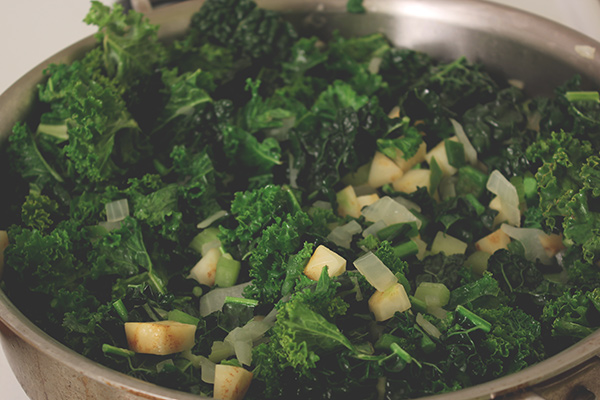
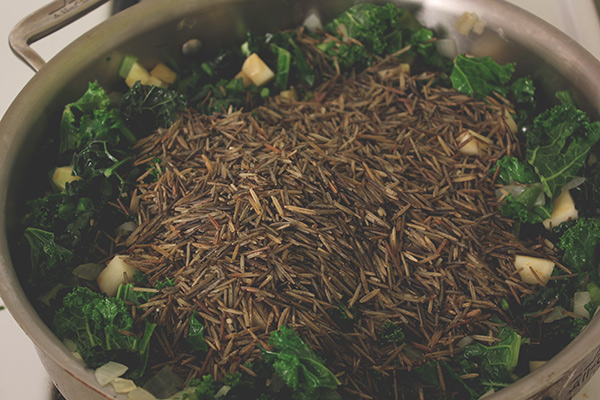

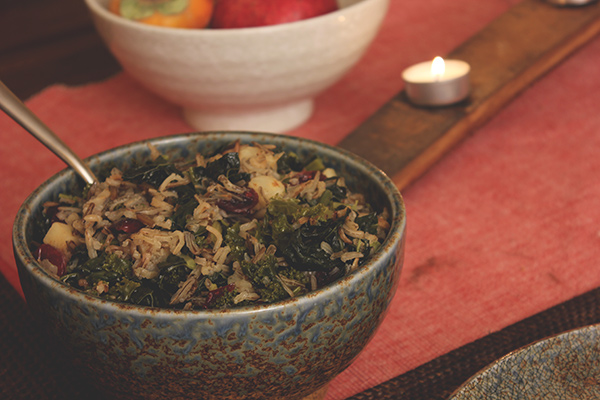
Noting the time of year it is, I would also be remiss if I didn’t tell you that this could certainly work on a holiday dinner table or at one of the many potlucks you might find yourself facing during the holiday season. We were content to eat the leftovers warm, room temperature, and even cold, and I love finding dishes that are just as comfortable on a nicely set holiday table as they are eaten on the couch on a Tuesday night. If you’re looking for a way to get started with wild rice, this is definitely it.
And if you’re looking for other ways to use wild rice, here are those three recipes I alluded to:
- Creamy wild rice soup: the beloved Byerly’s version is my standby, minus the almonds, and sometime this winter I will update the related post I wrote here many moons ago
- Chicken and wild rice hot dish: Amy Thielen, no surprise, comes through as my new favorite – though I don’t butter the dish and halve the rest of the butter in the recipe
- This wild rice salad with edamame and Asian dressing
For years I’ve also been meaning to bake with wild rice. My grandmother often mentions a savory wild rice cake she used to make, and I could also see a slightly sweet version being delicious (and perhaps similar to the only slightly-sweet poppy seed cakes we love to eat when we’re in Austria). Adding wild rice to sourdough bread would be delicious as well, as would be wild rice in pancakes or perhaps pumpkin or squash breads. If I find great new recipes, they’ll end up here.
Wild rice vegetable pilaf
Adapted loosely from a recipe in From Asparagus to Zucchini
Makes 4 moderate main dish or 6-8 side dish servings, easily scalable (note that I made a double batch in the pictures above)
- 1-2 Tbsp. cooking oil (olive, canola, etc.)
- 2-3 cups vegetables, processed for sautéing (e.g. diced onion, celery, celeriac, carrots, squash, peppers; sliced mushrooms; chopped or shredded greens) In this case, I used diced onion, celery, celeriac, and poblano peppers and roughly chopped kale
- 1 cup wild rice, rinsed and drained
- 2 cups chicken, vegetable, and/or beef stock (or water, in a pinch)
- 1/4 cup dried cranberries, golden raisins, and/or currants
- 1 tsp. salt, plus more to taste
– Cook the vegetables In a large skillet, heat the cooking oil over medium-high heat. Add the vegetables, starting with heartier, longer-cooking vegetables and moving on to more delicate, quick-cooking ones, and sauté until they’re mostly tender.
– Add and cook rice Add rice and stock, and add 1 tsp. salt. Bring to a boil, cover, and lower to a simmer. Cook until rice is nearly tender, 30-60 minutes (depending largely on the rice). Stir in dried fruit and cook uncovered for another 5 minutes. Season with salt as needed and serve.
Making ahead/storage: This fully cooked dish will keep well in a sealed container in the refrigerator for up to 5 days. Briefly heat in a pan, adding water or other liquid as necessary, to reheat.










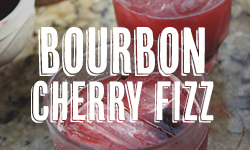
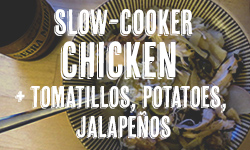
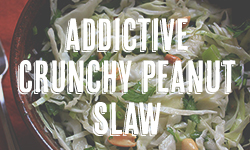
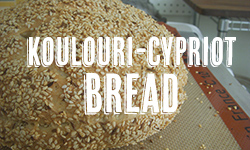
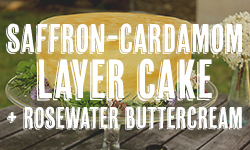


Yum! I always forget about wild rice and how delicious it is. And I haven’t even had the real thing. I’m going to see if I can sneak this on my family’s table at Thanksgiving.
This looks so delicious! I can’t wait to try it. Thank you for sharing.
thanks for the history lesson! i’m a minnesotan and had NO IDEA about how particular it is to our region. i’m certainly making this recipe this winter.